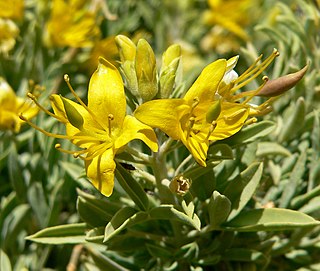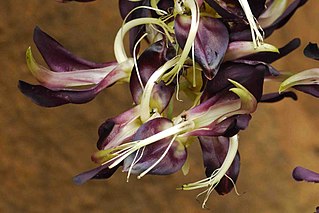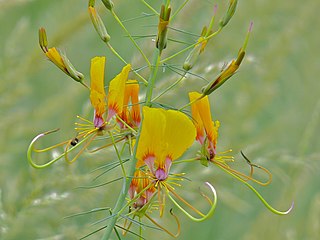
The Brassicales are an order of flowering plants, belonging to the eurosids II group of dicotyledons under the APG II system. One character common to many members of the order is the production of glucosinolate compounds. Most systems of classification have included this order, although sometimes under the name Capparales.

The Capparaceae, commonly known as the caper family, are a family of plants in the order Brassicales. As currently circumscribed, the family contains 15 genera and about 430 species. The largest genera are Capparis, Morisonia, Maerua, Boscia, and Cadaba.

Cleome is a genus of flowering plants in the family Cleomaceae, commonly known as spider flowers, spider plants, spider weeds, or bee plants. Previously, it had been placed in the family Capparaceae, until DNA studies found the Cleomaceae genera to be more closely related to the Brassicaceae than the Capparaceae. Cleome and clammyweed can sometimes be confused.

The Cleomaceae are a small family of flowering plants in the order Brassicales, comprising about 220 species in two genera, Cleome and Cleomella. These genera were previously included in the family Capparaceae, but were raised to a distinct family when DNA evidence suggested the genera included in it are more closely related to the Brassicaceae than they are to the Capparaceae. The APG II system allows for Cleomaceae to be included in Brassicaceae. Cleomaceae includes C3, C3–C4, and C4 photosynthesis species.

Cleomella is a genus of flowering plants. It includes 22 species of native to North America, ranging from southern Mexico through the western and central United States to western and central Canada. Like their relatives, the cleomes, plants of this genus have traditionally been included in the caper family Capparaceae but have recently been moved into a new family, Cleomaceae. Cleomella are annual wildflowers native to the dry and desert regions of western North America. They are similar to cleomes in appearance. They are erect and branching with leaves divided into three leaflets and inflorescences of yellow flowers with long stamens. Cleomella species are known commonly as stinkweeds or simply cleomellas.

Cleomella arborea, is a perennial shrub or bush in the spiderflower family (Cleomaceae) known by the common names bladderpod, bladderpod spiderflower and burro-fat. It has yellow flowers in bloom all months of the year. It emits a foul odor to discourage herbivory from insects.
Silentvalleya is a genus of Indian plants in the grass family.
Hubbardia is a genus in the grass family that is endemic to India. It is the only genus in the tribe Hubbardieae of the subfamily Micrairoideae.

Jansenella is a genus of Asian plants in the grass family.

Camptorrhiza is a genus of plants native to India and southern Africa. It contains two recognized species:

Cleome viscosa, the Asian spiderflower or tick weed is an annual herb that grows up to a meter high. It belongs to the family Cleomaceae. It is considered an invasive species and is widely distributed in warm and humid habitats across the Americas, Africa and Asia, and in Australia. It is commonly found during the rainy season.
Cleome arenitensis is a species of plant in the Cleomaceae family and is found in Western Australia.
Cleome cleomoides, commonly known as Justago, is a species of plant in the Cleomaceae family and is found in Western Australia.
Cleome kenneallyi is a species of plant in the Cleomaceae family and is found in Western Australia.
Cleome oxalidea is a species of plant in the Cleomaceae family and is found in Western Australia.
Cleome tetrandra is a species of plant in the Cleomaceae family and is found in Western Australia.

Mucuna monosperma, commonly known as negro beans in India, or deer-eye beans, donkey-eye beans, or ox-eye beans, is a large woody climber from the family Fabaceae. The plant has three layers; a brown pod covered in small hairs, curved petals usually colored purple and black round-shaped beans. Small hairs on the pod can irritate the skin.The petals of the Muncuna monnosperma flower opens at night and closes in the morning. It is found in India, including the eastern Himalayas, the northeastern states, and the Andaman and Nicobar Islands, Sri Lanka, Bangladesh, Myanmar, and Thailand. It's natural habitat is evergreen forests, and it commonly grows near swamps or along streams.

Mucuna sanjappae is a perennial woody twiner from the family Fabaceae. It is endemic to India (Maharashtra), having been recorded from Junnar in Maharashtra.

Cleome angustifolia, known as golden cleome, yellow cleome or yellow mouse whiskers, is an African species of plant in the Cleomaceae family. It is common along roadsides and in disturbed areas and is eaten as vegetable locally. Swedish naturalist Peter Forsskål described C. angustifolia in 1775. It is one of three species in genus Cleome (the others being C. gynandra and C. oxalidea) that independently acquired the C4 pathway of carbon fixation. A species close to C. angustifolia, Cleome paradoxa, is C3–C4 intermediate.

Mamiyil Sabu formerly Head of the Department of Botany, University of Calicut and currently working as CSIR-Emeritus Scientist at Malabar Botanical Garden and Institute for Plant Sciences, Kozhikode district, Kerala, India. He worked for over 37 years on the research of gingers, which include families such as Cannaceae, Marantaceae, Zingiberaceae, Heliconiaceae, Costaceae, Musaceae etc. A comprehensive work on these groups have been taken after a gap of 125 years, which resulted in the discovery of several new species and rediscovery of many species after 155 years.













